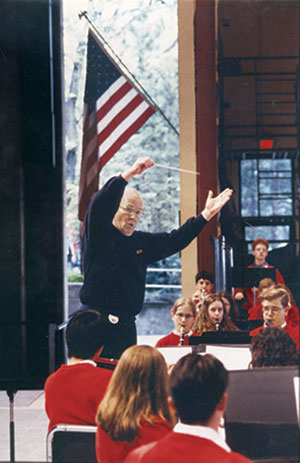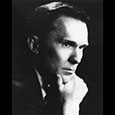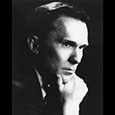
What distinguishes the activity of the conductor from that of all other musicians? That he does not play himself, but guides and influences the playing of others. It is not before he enters on the professional phase of his vocation that he can really come to know the handling of his instrument, the orchestra.1
This instinctive faculty for immediately transmitting one’s own musical impulses to the orchestra is the sign of true talent for conducting.2
– Bruno Walter
We prepare ourselves to be conductors through formal training at colleges, universities, and conservatories in the areas of music history, music theory, counterpoint, composition, and orchestration. We learn our craft by studying a number of instruments in order to more fully understand the complete scope of our profession. We also acquire skills in non-verbal communication and score reading through courses in the art of conducting. Prior to this comprehensive study of music, each potential band conductor should have achieved some degree of competence on at least one wind or percussion instrument. The importance of this competence as a performer cannot be underestimated; a conductor must develop musical sensitivity as a participant before hoping to inspire and guide others in making music. This is not to say that all musically sensitive performers are capable of being fine conductors – it is only to suggest that few musically sensitive conductors have become so without first having experienced the role of the musically sensitive performer. Furthermore, it is my personal conviction that a conductor should make every effort to continue performing on their instrument – not only to set an example for student, but to better understand the performers in the ensembles.
Appreciation of music of all mediums is an important characteristic of the musical band conductor. Such a conductor studies not only the great wind masterpieces, but also constantly revisits the great symphonies and string quartets, as well as the numerous masterpieces in all other areas of music. The recent compositions of Elliott Carter, Gunther Schuller, or Pierre Boulez are of just as much interest as the latest work from the pen of Karel Husa. The conductor seeks out opportunities to hear chamber music, new music ensembles, and the finest symphony orchestras. Such a conductor, for example, may decide to take time out from the many activities of the Midwest Band and Orchestra Clinic in Chicago each December to walk a few blocks to hear the Chicago Symphony perform, and will recognize that this experience might well be more valuable to growth as a band conductor than any of the scheduled activities of the clinic.
Growth is perhaps the most important element in the musicianship of a successful band conductor. The music world is changing at such a rapid rate that constant study, exploration, and open-mindedness are necessary if one is not to fall hopelessly behind. The ability to grow and to expand our range of knowledge is particularly important to those of us associated with the wind band for we have a unique place in the music of the future. We must be alert and able to respond to the new opportunities presented to us, or we will find that once again the world of music has by-passed our medium.
Concept of the Score
The question is often asked, “How do you study a score?” There is no system that applies to all scores and all conductors. One approaches a new score as one approaches a crossword puzzle – by trying to discover several key ideas that will lead to a complete understanding of the work. Each composition is a new experience and presents a challenge to the conductor. It is here that the conductor calls upon past study of theory, counterpoint, form, history and other aspects of formal and informal training. Naturally, knowledge of the composer’s complete works, styles, and biography is of vital importance as are specific facts regarding the piece under study and its relation to the other works by the composer.
Implicit in knowledge of the score is the conductor’s personal concept of all details such as balance, weight, emphasis, and phrasing which make one conductor’s interpretation different from that of another. Most composers expect the conductor to use musical judgment to interpret the idea of the composition. As an example, several years ago I was rehearsing Emblems by Aaron Copland while the composer himself was present. When I looked through the score in my study, I felt that the tempo marked in one section was too fast. During the rehearsal of this section, I turned to Mr. Copland to ask if the section was too slow for his liking. He commented that he would have conducted it faster, but that it was musical and should not be changed to the faster tempo indicated. I offered to change the tempo to suit him, but he insisted that it be an interpretation which I felt best for his piece. Composers, with the exception of Stravinsky and a few others, expect conductors to bring their own interpretations to the work, as long as it is consistent with stylistic traditions of the period and other guidelines already mentioned.
If the conductor has studied the composition in a detailed manner, rehearsals will be more efficient. Discovering problems quickly and solving them rapidly, requires familiarity with a work in all of its details. Without such preparation, the conductor will be forced to establish balance and interpretation on the basis of spontaneous, casual adjustments (and this is the mark of a conductor who learns the composition during rehearsal). Eugen Jochum, a well-known European conductor, states this idea very well.
[The conductor’s] own inner analysis of the composition, the identification with the will of the composer, precedes his work with the orchestra. It would be too late to come to his conception of the piece when working with the orchestra, although certain aspects can still be perfected by actually hearing the work.3
There is no fixed formula for successful score study. Each conductor must find their own technique. When I asked Frederick Fennell how he studies a score, the answer was, “I just live with it.” One never reaches the end in the study of a score. It is a constant process involving the combination of one’s total knowledge of music with an understanding of the myriad of details which make up a specific work – and all of this before the first rehearsal takes place!
Baton Technique
Motion is the language of conducting; through motion the conductor displays the inner-most sensitivity toward the music as a physically sounding medium. The conductor is constantly either sensitizing the musicians to visual signs – because they are effective means of communication – or desensitizing the musicians to these signs because they tend to be monotonous or awkward and convey only the most elementary musical aspects of pulse, volume, and general style.
A common problem to many band conductors is the visual screen. A conductor sets up a barrier to communication by using large and repetitious motions. In order to get the attention of the performers, the conductor must somehow break through this visual screen of non-communicative motions. Unfortunately, some conductors attempt to do this by using even larger motions than before, creating an even greater barrier – and the cycle continues.
We have all observed a large number of band conductors whose conducting technique could best be described as unrefined. These conductors seem to feel that they must constantly supply energy (through frantic, non-stop arm-waving) to the music-making machine. The fact is, however, that even a moderately good ensemble is capable of a good deal of independence. That is, once a certain tempo, volume or style is established, a group will usually maintain it. Once the ensemble has established a forte volume, it is unnecessary for the conductor to constantly conduct forte – although an occasional reminder is helpful. The same is true of general style and pulse. After the speed of a piece with a strong steady pulse is set, the conductor is free to help in other more subtle areas of interpretation.
It is important to understand when and what not to conduct. It is a well-known fact that most inexperienced conductors tend to over-conduct, thus limiting their effectiveness by setting up the visual screen mentioned earlier. To overcome this habit, the conductor must consciously eliminate the sameness of beat and energy of motion. Appropriate and varied conducting gestures will command the attention and response of the players; unnecessary or monotonous ones will cease to have any effect at all.
Once the conductor has eliminated the visual screen and learned to communicate visually, there must be something to say. Performers look for and receive from a conductor’s motions not only when, how loud and how fast to play, but an infinite variety of subtle messages on all aspects of the music. In order to communicate these subtleties the conductor must feel the music as physical texture and describe it visually to the players. To a sensitive conductor, music is not only an aural art but a physical art as well. For example, accents in the music of Haydn, Beethoven, Brahms, Wagner, and Stravinsky not only sound different but feel different. The ability to respond physically to music is essential for a conductor to convey, through outward motions, understanding and interpretation. The conductor must feel the power of the final movement of Symphony in Bb by Hindemith or the fragile texture of the second movement of the Sinfonietta by Ingolf Dahl. Sensitivity must be refined beyond whole movements or compositions to include individual phrases, fragments and even isolated sounds. It is this ability to understand and communicate the physical element of music that too often is missing from an otherwise technically superb conductor.
Personal Characteristics
Perhaps the most elusive aspect of conducting is the psychological impact of the personality. This aspect was described by Elizabeth Green in her excellent book, The Modern Conductor, as “impulse of will.”4 It is that intangible quality which is so essential to the successful conductor. William Steinberg, well-known music director of the Pittsburgh Symphony says, “The only factor that counts is the power of [the conductor’s]
personality.”5 The conductor must certainly have confidence, poise, enthusiasm, and eye contact. It is also imperative to understand group psychology, motivation techniques, and to display musical sensitivity. “He who cannot deal with people or exert his influence on them is not fully qualified for this profession.”6
Bruno Walter was not only one of the great conductors, but he was also very articulate when writing about his profession. His personal philosophy is one which has guided me for some time. He expresses this philosophy so well in these words:
I realized that I was certainly not cut out to be a ruler or despot, but rather to be an educator who, as we know, methodically uses his empathy with others for gaining influence over them. My task was now to enforce the powerful, nay, irresistible demands of my musical personality by means of that empathy; to uphold my own ideals uncompromisingly without violation of other people’s. In general it can be said that a violent manner of dealing with people will either be defeated by their resistance or result in their intimidation. On the other hand, the milder methods of psychological empathy, persuasion, and moral intermediation will have an encouraging and productive effect.7
When a well-educated conductor who has prepared the score, has the ability to communicate visually, and has personal qualities to lead others stands before an ensemble – whether orchestra or band – there is an awesome responsibility, the responsibility to make music. Serge Koussevitzky, conductor of the Boston Symphony orchestra from 1924 to 1949, made important comments on precisely this point:
Nowadays we can often hear “authorities” exclaim, in reviewing a performance: “Let the music speak for itself!” The danger of this maxim lies in its paving the way for mediocrities who simply play a piece off accurately and then maintain that he “let the music speak for itself.” Such a statement is not right, in any event, because a talented artist renders a work as he conceives it, according to his own temperament and insight, no matter how painstakingly he follows the score markings. And the deeper the interpreter’s insight, the greater and more vital the performance.8
This responsibility that Koussevitzky understood so well may seem obvious, but it is often the greatest weakness of band conductors. How often it is in our band world that conductors use their abilities only to put the elements of music in order. Tone quality, intonation, precision, correct notes, balance, dynamic and articulation markings are all important and must receive sufficient attention if they are not to detract from the music making process, but we must never lose sight of the larger purpose of our role as conductors – that of interpreters. As interpreters, we must constantly call upon our knowledge, training, and unique artistic sensitivity to enable us to fulfill this most challenging role. Viewed in this light, the profession of band conducting assumes a depth and potential of exciting proportions.
Endnotes
1 Bruno Walter, Of Music and Music Making (New York: Norton, 1961), p. 83.
2 Ibid., p. 112.
3 Carl Bamberger (ed.), The Conductor’s Art (New York: McGraw-Hill, 1965), pp. 258-259.
4 Elizabeth A.H. Green, The Modem Conductor (Englewood Cliffs, NJ: Prentice Hall, 1961), p. 60.
5 Bamberger, p. 306.
6 Bruno Walter, p. 111.
7 Ibid., p. 120.
8 Bamberger, p. 144.






